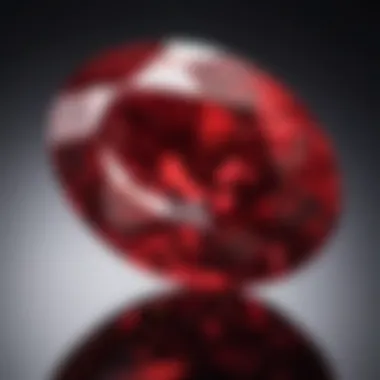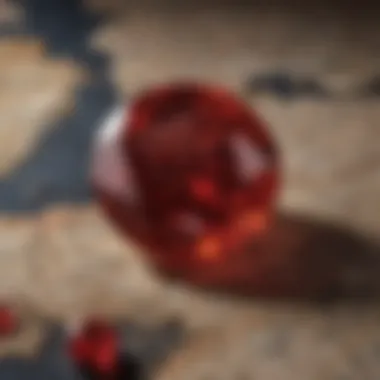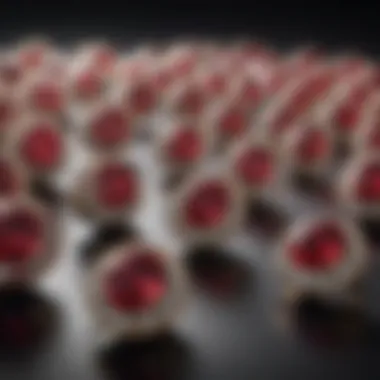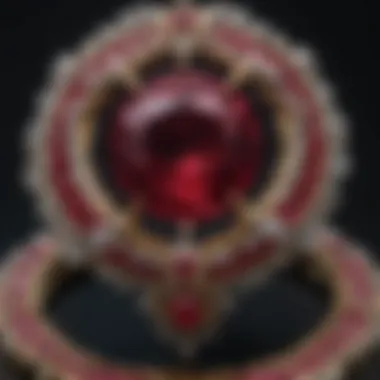Factors Affecting One Carat Ruby Prices Explained


Intro
Gemstone Overview
In the realm of gemstones, rubies hold a place of prominence by virtue of their striking beauty and symbolic significance. Rubies are a variety of corundum, the same mineral that produces sapphires. Their vibrant red color derives from the presence of chromium, which can vary in intensity. The finer the hue, the more valuable the stone.
- Definition and characteristics
Rubies are admired for their intense color and brilliance. A high-quality ruby, which often displays a vivid red with slight traces of blue, tends to command a higher price. Clarity is also crucial; the fewer imperfections present, the more desirable the ruby is to collectors. - Classification of gemstones
Gemstones can be broadly classified into three categories: precious, semi-precious, and organic. Rubies are categorized as precious gemstones alongside diamonds, sapphires, and emeralds. This classification is based on their rarity and the market demand for these stones.
Properties of Gemstones
Understanding the physical and chemical properties of rubies provides insight into their valuation. Such properties play a significant role in how consumers perceive these beautiful gems.
- Physical properties
Rubies have a hardness rating of 9 on the Mohs scale, making them one of the toughest gemstones. This durability is crucial for jewelry, especially pieces that are worn daily such as rings and bracelets. Their brilliant luster and ability to reflect light enhance their appeal in various settings, from engagement rings to statement pieces. - Chemical properties
The chemical composition of rubies is straightforward: they are essentially aluminum oxide with traces of chromium. This simple composition belies the complexity of their appearance. Differences in the purity of the chromium, along with other trace elements, can drastically change everything from the hue to the value.
"The allure of rubies lies in their mystique and history, making them not just stones, but treasures of emotional investment."
Understanding these properties and classifications enriches the discussion around the price of one carat rubies. It not only offers a foundational grasp but creates a bridge to exploring the economic factors that govern their market value.
Prologue to Ruby Pricing
The discussion surrounding the pricing of one carat rubies goes beyond mere numbers; it delves into a tapestry woven with factors that influence value and desirability. Understanding ruby pricing is pivotal for anyone interested in owning or selling this precious gemstone. As with any marketable item, the valuation of rubies is determined by a confluence of aspects including quality, origin, market trends, and even the cultural significance these stones hold in various societies.
One of the most intriguing elements that tie into ruby pricing is the concept of carat weight. It’s not simply a matter of size — a one carat ruby can have vastly different values depending on its characteristics. This makes it essential for buyers and sellers alike to have an informed grasp of what makes a ruby worth its price tag.
In essence, a deeper understanding of ruby pricing not only aids gem enthusiasts and collectors in making well-informed purchases but also enhances their appreciation for these extraordinary gemstones. The exploration of historical contexts provides a lens through which one can understand how perceptions of value have transformed over time. Pay attention to the historical journey that rubies have undertaken, as it sheds light on current expectations in the marketplace.
Defining Carat Weight
Carat weight is a significant factor that plays a big role in determining the price of a ruby. One carat is equivalent to 200 milligrams, but the implications of carat weight stretch far beyond its physical dimensions. In the world of gemstones, weight often correlates to value, as larger stones are rarer and, therefore, more coveted. However, a key point to note is that not all carats are created equal. A one carat ruby that is of high quality could potentially outshine a larger stone with inferior characteristics.
When evaluating carat weight, it’s also important to consider the stone's visual appeal, which can fluctuate depend on how different weights interact with light. For instance, a well-cut one carat ruby can appear larger, dazzling buyers and collectors with its luster and brilliance. Thus, discerning buyers should demand clarity on what makes a ruby's carat weight significant — it’s often a blend of science and artistry.
Historical Context of Ruby Valuation
To appreciate the current pricing of rubies, one must look back to their rich history. For centuries, rubies have been treasured not only for their beauty but also for their supposed metaphysical properties. In ancient cultures, these gemstones were often believed to hold powers that could enhance one’s vitality and ward off misfortune. The significance of rubies was evident in royal collections, where they adorned crowns and jewelry, symbolizing wealth and status.
In terms of valuation, the historical ties to various regions also come into play. For instance, rubies from Burma have long been celebrated for their deep red hues and brilliance, situating them at a higher price point in comparison to rubies sourced from different regions. Over time, these associations have influenced market perceptions and pricing mechanisms surrounding rubies.
The journey of rubies through different eras — from ancient civilizations to modern luxury collectors — illustrates how pricing is not static but rather an evolving narrative. This understanding invites buyers to reflect on the stories their rubies carry, adding an emotional depth that transcends monetary value.
"A ruby’s price is both an art and a science, intertwining historical context and personal story."
By grasping the intricacies of how carat weight and historical significance affect ruby pricing, enthusiasts are better equipped to navigate the complex landscape of gemstone valuation. Through this understanding, not only do they enhance their purchase experience, but they also build a lasting relationship with these timeless treasures.
Quality Factors Affecting Price
When considering the price of a one carat ruby, quality factors play a pivotal role. These elements determine not just the visual appeal of the gemstone, but also its market value. Understanding the nuances behind quality can empower gemstone enthusiasts and collectors alike, providing insights that can influence buying decisions. The interplay of color, clarity, and cut often crown the discussion about quality, each factor bearing its own weight in the final valuation of a ruby. Let's delve deeper into these critical elements.
Color Characteristics
Color is perhaps the most significant determinant in assessing a ruby's value. A high-quality ruby exhibits a vibrant, rich red hue, often referred to as pigeon blood red. This term denotes a particular saturation and brightness that makes rubies so sought after.


The color can be categorized into three primary aspects: hue, tone, and saturation.
- Hue: The basic color of the ruby. Ideally, one seeks a true red, though secondary tones such as purples or pinks can appear, sometimes detracting from value.
- Tone: This refers to the lightness or darkness of the color. The best rubies typically display a medium-tone.
- Saturation: The intensity of the color. A saturated ruby will catch the eye, while a dull shade directs the opposite response.
Interestingly, the geographic origin of rubies can also affect their color. For instance, rubies from Myanmar often maintain that coveted pigeon blood hue, while stones from other locales may bring different shades to the table. This is something collectors should consider when appraising potential purchases.
Clarity and Transparency
Clarity levels can make or break a ruby's pricing. Just like many gemstones, rubies can have inclusions and blemishes; however, their visibility significantly impacts value. A clear ruby with few, if any, inclusions is usually priced higher than one with observable flaws.
There are different clarity grades:
- Eye-Clean: No inclusions visible without magnification. These rubies tend to command top dollar.
- Slightly Included: Minor inclusions noticeable under magnification but not visible to the naked eye.
- Included: Inclusions that can be seen without any tools detract from the stone's value significantly.
Transparency is also crucial. The more transparent a ruby is, the more light it can reflect, enhancing its luster and appeal. It’s essential to note that some inclusions might even add character to a gemstone, creating a unique story for the ruby.
Cut and Shape Considerations
The cut of a ruby can seem somewhat less significant than color or clarity, yet it carries its own weight in the valuation process. A well-cut ruby is not only about aesthetics; it also influences how light interacts with the gemstone, consequently enhancing its brilliance and sparkle.
Common cuts include:
- Round: Often associated with traditional elegance, this shape can maximize light return.
- Oval: An elongation can give the impression of a larger size, appealing to buyers.
- Emerald: This cut can highlight clarity and color, often appreciated for its sophisticated appearance.
Also, it’s important to note that changes in fashion and market demand can shift preferences for certain shapes and cuts. For example, in recent years, unique cuts like cushion and pear have gained popularity, but their general appeal can fluctuate.
"In the world of gemstones, clarity and cut can often outshine even the most vivid color. "
By recognizing how these elements work together, you can embark on your journey with a clearer vision of what impacts ruby pricing.
Origin and Its Impact on Value
The origin of a ruby plays a pivotal role in its evaluation and pricing. Different regions not only yield varying qualities of rubies but also carry unique connotations that can elevate their desirability in the eyes of buyers. Understanding the nuances of origin can empower gemstone enthusiasts and collectors to make informed decisions. When looking at rubies, it’s vital to recognize how geographic location intertwines with market perceptions and valuation.
Birman Rubies
Birman rubies, hailing from Myanmar (formerly known as Burma), are often hailed as some of the finest in the world. Characterized by their deep, vibrant red hues, these gems possess an exquisite quality that collectors crave. The historical significance of Burmese rubies extends beyond mere aesthetics; they have long been associated with nobility and power. This connection has imbued them with cultural resonance that affects their price. For many, the provenance adds a certain level of prestige, transforming the gem from a simple jewelry piece into a collectible artifact.
Factors contributing to the value of Birman rubies include:
- Color saturation: The rich, pigeon blood red is most prized.
- Clarity: Lesser inclusions can skyrocket the price compared to those riddled with visible imperfections.
- Scarcity: Political issues have led to reduced availability in the global market, further inflating desire and dollar.
Collectively, these elements make Birman rubies a staple in the luxury gemstone sector, and their origin is central to understanding their marketplace viability.
Thai Rubies
Next, we examine Thai rubies, known for their vibrant red shades blended with a slightly purplish tint. Originating from Thailand, these gems were historically significant in the local gemstone trade, drawing buyers from all corners of the globe. While they may not command the same high prices as their Burmese counterparts, the affordable and flashy nature of Thai rubies has made them popular among jewelry designers and enthusiasts alike.
Key points to note regarding Thai rubies include:
- Color Variability: They often display a lighter hue as compared to Burmese rubies, which can affect their market standing.
- Market Accessibility: With a broader supply, these rubies are more accessible for general consumers.
- Cultural Roots: In Thailand, rubies are often linked to luck and prosperity, enriching their narrative value.


In essence, while Thai rubies may not always achieve the dizzying heights of Birman gems, their charm lies in their unique characteristics and cultural associations.
African Rubies
African rubies have taken the global gemstone market by storm in recent years. Found mainly in countries like Mozambique and Madagascar, these stones are famous for their intense reds and remarkable clarity. The introduction of African rubies has significantly altered pricing dynamics, mainly due to increased supply and adventurous mining operations.
Considerations for African rubies include:
- Emerging Markets: As more gems enter the market, pricing can be competitive, attracting a diverse range of buyers.
- Quality Variation: The quality of African rubies can vary widely; therefore, each stone must be assessed on its own merits.
- Sustainability Concerns: Buyers are increasingly attentive to how gemstones are sourced, with ethical mining practices gaining importance.
It's worthwhile to note that the popularity of African rubies indicates a growing appreciation for diverse origins, reflecting a shift in consumer priorities.
In summary, origin is not merely about geography; it encapsulates a rich tapestry of cultural, historical, and economic factors that shape the valuation of rubies. Each region contributes distinctive characteristics that educators and collectors must appreciate when determining market prices.
Market Trends and Fluctuations
Understanding market trends and fluctuations is crucial for anyone involved in the ruby trade or simply fascinated by these exquisite gemstones. The pricing of rubies is not static; it ebbs and flows in response to numerous factors, including economic conditions, consumer demand, and cultural shifts. Recognizing these dynamics can help collectors and buyers make informed decisions, ensuring they get value for their investment or appreciation.
Global Economic Influences
Global economic conditions play a significant role in determining the price of rubies. When the economy is thriving, people tend to spend more on luxury items, including gemstones. Conversely, during economic downturns, the demand can drop drastically. For instance, when the global economy faced challenges in recent years, many industries experienced a dip, and the luxury goods market followed suit.
Certain countries with strong purchasing power, like the United States or China, significantly influence ruby prices. For example, the rise in affluent middle class in Asia has recently shifted demand towards high-quality rubies, driving prices upward. Furthermore, exchange rates can affect international transactions, making rubies more or less expensive depending on the currency in use.
Supply Chain Dynamics
The supply chain for rubies is complex and can significantly impact their availability and price. Various elements, including mining practices and geographic locations, play a crucial role in this equation. If we look at significant sources of rubies in Thailand, Myanmar, and Africa, the conditions surrounding these mines can differ vastly.
For instance, when political unrest occurs in Myanmar, it can interrupt ruby production, limiting supply and consequently driving up prices. Similarly, if a region experiences natural disasters or environmental regulations that limit mining activities, the scarcity can create a price surge. Factors such as logistics and transportation also contribute; if shipping costs rise due to fuel prices, these increased costs can influence retail prices as well.
"The balance between supply and demand is like a seesaw; a slight shift can tip the scales and affect pricing notably."
Auction Prices and High-Profile Sales
Auction houses play a pivotal role in setting trends for ruby prices. Exceptional rubies sold at prestigious auctions can create a ripple effect throughout the market. High-profile sales often attract media attention and can cause a surge in demand for similar stones. An example of this is the famous "Red Emperor", which fetched a staggering price at auction, leading collectors to seek comparable gems, thereby driving prices higher for quality stones.
Auction platforms like Sotheby’s and Christie’s are known for hosting sales that display the most exquisite rubies in various shades and sizes, showcasing their potential value. Some rubies can sell for more than their weight in gold, making them not just precious but a solid investment for those who have an eye for quality.
As we dive deeper into the intricacies of the ruby market, it is clear that tracking these market trends and fluctuations will arm enthusiasts and collectors with the knowledge they need to succeed. Understanding the interconnectedness of these factors allows for a more nuanced view, enabling one to appreciate the true value of one carat rubies.
Cultural and Historical Significance
The cultural and historical significance of rubies extends far beyond their beauty and inherent value. These gems have been admired, revered, and enshrined in various cultures for centuries. Understanding their role in history and symbolism brings more depth to one's appreciation of rubies, especially when considering their market price. It's not just the stone itself, but the stories, beliefs, and traditions woven around it that influence its value.
Rubies symbolize passion, power, and protection. In certain cultures, they are regarded as a talisman for good fortune and health, enhancing their desirability and, consequently, their price. Hence, a keen awareness of these cultural beliefs can be crucial for anyone looking to invest in rubies. Their significance often drives demand, reinforcing market trends that could lead to price increases.
Symbolism in Different Cultures
From ancient civilizations to modern societies, rubies have had a notable presence. In ancient India, rubies were considered to be the gemstones of royalty. They adorned the crowns of kings and queens, serving not only as decorative pieces but also as symbols of wealth and authority. The brighter the red, the more powerful the stone was believed to be.
- In African cultures, rubies are sometimes linked to the spirit world, believed to impart strength to the wearer.
- Buddhism views rubies as a means of achieving enlightenment, encouraging self-discovery and inner peace.
- In Christianity, rubies are often connected to the blood of Christ, symbolizing sacrifice and love.


Each of these cultural interpretations can lead to varying perceptions of value. When ruby prices fluctuate, it might not only be due to market forces but also cultural reverberations surrounding these stones.
Rubies in Historical Context
Historically, rubies have graced the pages of many civilizations. The ancient Romans sought them for their vivid hue, while in the Medieval Europe, they were thought to protect against evil and bestow wisdom. In fact, rubies were once so precious that they were often considered more valuable than diamonds. The belief that rubies could carry the dreams and aspirations of their owners contributed to their mystique.
"Rubies are the most highly prized colored gemstones, with qualities that transcend their physical attributes".
Even today, the history of rubies captivates collectors and enthusiasts. The late 20th to early 21st centuries saw a resurgence in ruby demand, particularly among Asian buyers, reinforcing the historical narrative that these gemstones have long been associated with prestige and power. Collectors frequently pay top dollar for stones that have historical provenance, linking them to famous owners or specific periods.
In essence, understanding the cultural and historical significance of rubies helps illuminate the sometimes dizzying numbers tied to their prices. The interplay between history, culture, and economics is vital in assessing the true worth of these captivating gemstones.
Evaluating Ruby Prices
Evaluating the price of rubies is an essential aspect of understanding their market value and ensuring informed purchasing decisions. Buying a gemstone, especially a ruby, isn't a simple task. It’s a blend of art and science, where one must consider a myriad of factors contributing to their overall worth. An accurate evaluation helps collectors and enthusiasts appreciate their investments effectively and aids jewelers in crafting exquisite pieces.
When assessing ruby prices, various elements come into play:
- Quality Assessment: The quality of the ruby is paramount, covering aspects such as color, clarity, and cut.
- Certification: Verification by recognized gemological institutions adds credibility and confidence to the purchase.
- Market Trends: The fluctuating demand for rubies can significantly influence prices.
Understanding these dynamics boils down to recognizing the interplay of several important factors.
Assessment by Professional Appraisers
Engaging with professional appraisers is often the first step in determining the value of a ruby. These experts utilize their knowledge of gemology and market trends to provide an objective assessment. They examine various parameters related to the stone:
- Color: The richness and depth of a ruby's color can make or break its value. The most sought-after hue is a vivid red with a hint of blue, commonly referred to as "pigeon's blood."
- Clarity: The presence or absence of inclusions is evaluated thoroughly. A clear stone, or one with minimal inclusions, is generally more valuable.
- Cut: The skill with which the ruby is cut can affect its brilliance. A well-cut ruby can enhance its color and make it more desirable.
Appraisers often follow established grading standards, like those from the Gemological Institute of America (GIA) or the American Gem Society (AGS), ensuring that their evaluations are consistent and trustworthy.
A thorough appraisal from a recognized professional not only gives peace of mind but also establishes a base value for insurance or resale considerations.
Using Gemological Certifications
Gemological certifications play a critical role in the evaluation of ruby prices. These documents provide essential information about the ruby's characteristics as assessed by qualified gemologists. Here are key points regarding the importance of certification:
- Credibility: A certification from a reputable gemological lab signals that the ruby has been examined under strict criteria. This fosters trust between buyers and sellers.
- Detailed Information: Certifications typically outline the ruby's carat weight, color grade, clarity grade, and cut grade. This comprehensive breakdown enables buyers to understand what they are purchasing clearly.
- Market Value: Certified rubies often command higher prices compared to non-certified stones due to the assurance that comes with authenticity.
In today’s digital age, it's easier than ever to access these certifications online and validate the information. For gem enthusiasts, this step is crucial for safeguarding investments.
Each step of evaluating ruby prices – from appraisals to certifications – combines to form a reliable picture of its market placement. Knowledgeable consumers are better equipped to navigate the complexities of the ruby market, enhancing their overall experience in enjoying and investing in these splendid gemstones.
Epilogue and Future Outlook
In wrapping up the discussions around the pricing of one carat rubies, it is essential to understand the pivotal role the current market dynamics play in shaping the value of these precious gemstones. As we've traversed through various sections in this article, we’ve illuminated how factors like quality, origin, and market trends significantly impact ruby valuations. The implications of these dynamics extend beyond mere numbers; they also reflect the inherent beauty and cultural resonance of rubies in societies around the world.
Current State of the Ruby Market
As it stands, the ruby market is in a fascinating phase, marked by fluctuations influenced by several different elements. Global demand for rubies, especially from emerging markets, remains robust. In particular, countries like China and India have shown an increasing appetite for high-quality gemstones. These developments, coupled with a scarcity of notable rubies, particularly those from traditional sources like Myanmar, have driven the prices upwards.
Additionally, e-commerce has begun to play a more prominent role in transactions. Online marketplaces have transformed how buyers and sellers interact. This has also introduced challenges in terms of ensuring authenticity and certification, making buyers more prudent and informed. Whether a gemstone is purchased from a physical store or online, ensuring proper grading and documentation is fundamental for buyers.
Predicted Trends in Pricing
Looking ahead, several trends seem poised to influence ruby pricing in the coming years. The continued rise in demand in luxury markets is one of the most notable factors. As gemstone enthusiasts and collectors become more educated and discerning, their focus will likely shift towards quality over quantity. Rubies that showcase vivid color and clarity will always command higher prices.
Furthermore, as mining activities become increasingly regulated, the availability of high-grade rubies may continue to dwindle. This could create an environment where prices steadily climb due to limited supply.
- Rising Interest in Ethical Sourcing: There is an increased focus on responsible mining practices, which may affect how rubies are sourced.
- Technological Advancements in Gemology: Innovations in gemstone testing and verification will offer clearer standards for valuing rubies, ultimately affecting market confidence.



